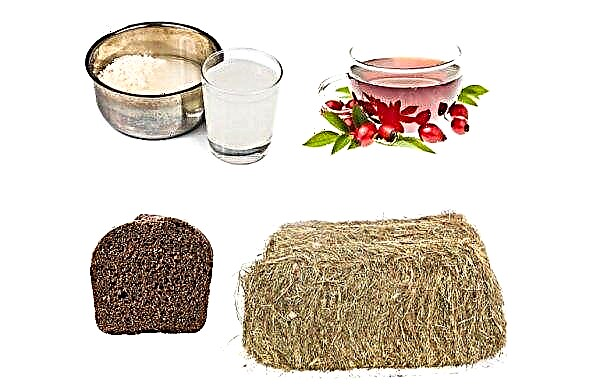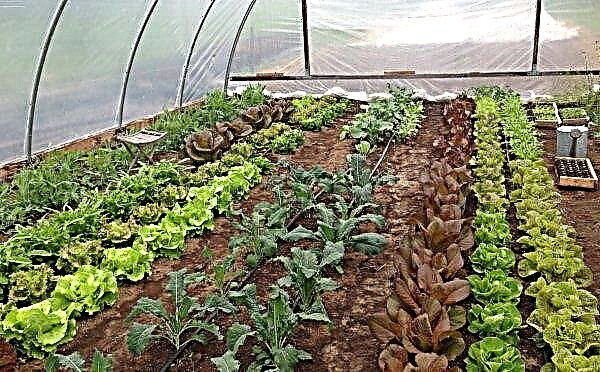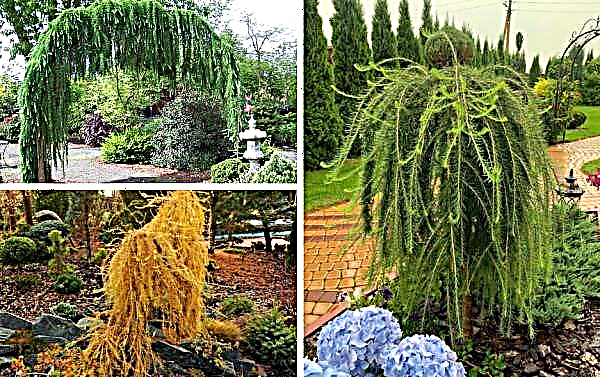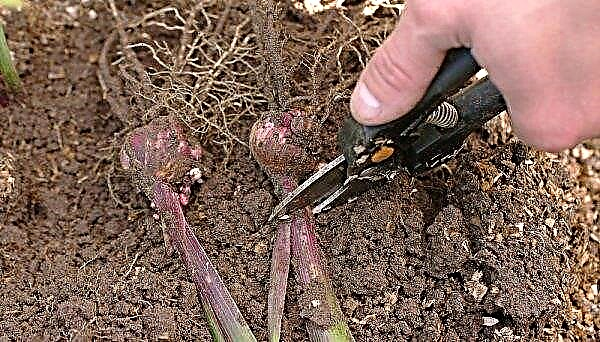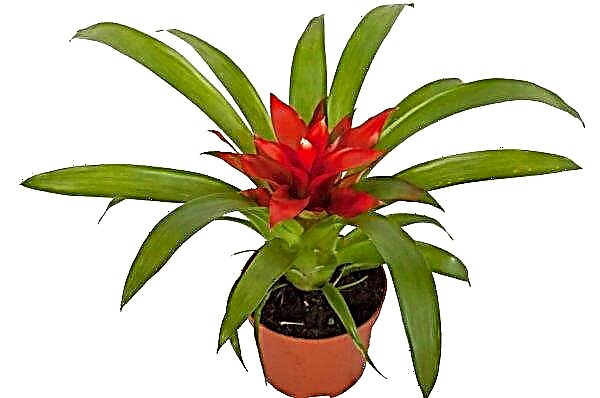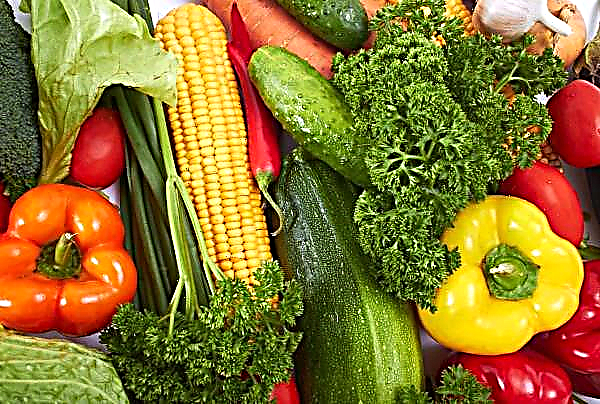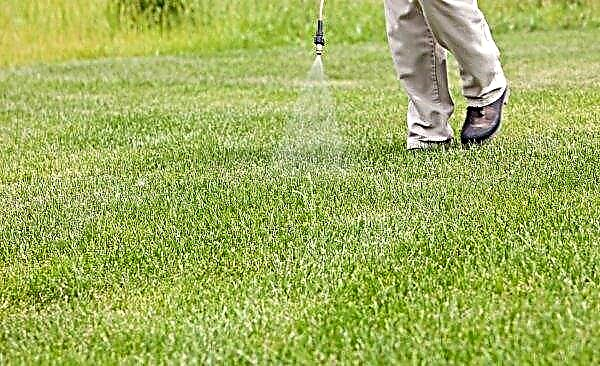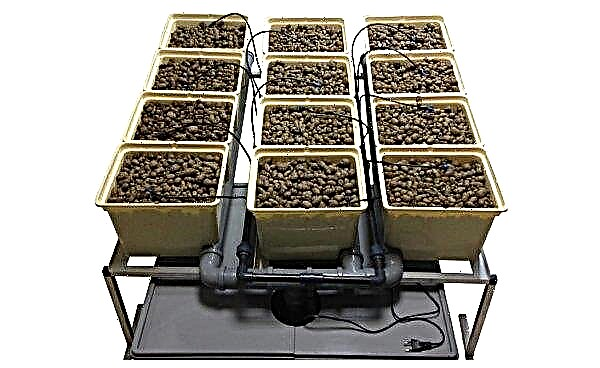Tomato "Pink Stella" is one of the favorites among gardeners. The variety is distinguished by good taste indicators and high productivity, excellent fruiting in open ground in warm regions and the middle lane, does not reduce productivity in greenhouse conditions when grown in cold areas.
Did you know? The birthplace of tomatoes is South America. There you can still find non-cultivated varieties. One of the most entertaining plants of this species is a tomato tree - cytomander. In the wild, it reaches 3.5–7 m in height. Its fruits are colored in purple, red or orange and are used to prepare various culinary delights.
Grade description
Characteristic features of the variety:
- "Pink Stella" refers to mid-early varieties - the fruits are ready for use after 110-120 days from the appearance of seedlings;
- bushes of the determinant type reach a height of 50 cm;
- a powerful main stem forms a small number of lateral shoots, so it does not need to be stalked;
- flowers are collected in inflorescences of 5-7 pieces;
- raspberry-pink pepper-shaped fruits are covered with a dense peel that protects against cracking;
- the mass of one fruit is 150–250 g;
- the pulp is dense, divided into 2–4 chambers containing a small amount of juice and seeds;
- the pulp has a pleasant fruity finish, sweetish with a slight sourness;
- on each bush up to 20 fruits ripen, which is about 3 kg;
- the fruits are immune to mechanical damage and tolerate transportation well, preserving their original qualities for a long time;
- the variety belongs to the table type and is intended for fresh consumption, however, the fruits are successfully used for canning, cooking various sauces, tomatoes;
- the variety tolerates weather extremes and is immune to most diseases with the organization of proper agricultural technology;
- compact bushes can be placed in 4 pieces per 1 square. m

Advantages and disadvantages
- Pros of breeding tomato Pink Stella:
- small dimensions of the bushes;
- high quality indicators of fruits;
- good yield;
- the possibility of growing in open and closed ground;
- resistance to adverse climate;
- long shelf life;
- universality in use.
- Among the shortcomings can only be noted:
- poor tolerance of return frosts when grown in open ground.
Self-growing seedlings
"Pink Stella" propagated by the seedling method. To achieve increased productivity, it is necessary to adhere to the rules of agricultural technology and organize comfortable conditions for seedlings.
Optimum timing for sowing
Sowing of seeds is carried out in February-March, taking into account the time for seed germination and the growing season, which at "Pink Stella" is 60 days. In total, seeds are planted 2.5 months before the final pick.
The soil
Tomatoes develop well on light, fertile soils with a neutral pH. At the site, soil begins to be prepared in the fall. It is best to plant tomatoes after winter crops or legumes. The site must be cleaned of vegetable debris, weeds, dig to a depth of 20 cm and disinfect with a 1% solution of copper sulfate.
After 3-4 days, fertilizers are applied per 1 sq. Km. m:
- 10 kg of manure;
- 40 g of superphosphate.
Important! If stored improperly, nitrogen from manure is converted to a volatile compound and it becomes unsuitable for use as fertilizer. To avoid this, manure is stored in special compost pits, periodically moisten it and added to the tops of weed grasses. After 2-3 years, manure is converted to humus, which is a valuable universal fertilizer, A good basis for growing seedlings and mulch. For mulching, humus is mixed in a 1: 1 ratio with garden soil.
After fertilizing, the soil is again dug up and left until spring. As soon as the soil warms up, it is again dug up, spilled with a solution of copper sulfate and after 2-3 days 10 kg of compost per 1 sq. M are applied. m
A universal substrate for solanaceous crops is prepared for seedlings or mixed independently from peat and sand in equal proportions. Prepared soil is poured with a hot ash solution. 400 g of ash are placed in 10 liters of water and boiled for 5 minutes.
Once the substrate has cooled, add humus - 1/2 of the total soil mass. The cooled soil is placed in containers for seedlings.
Capacity for growing
For sowing seeds, you can use different types of containers:
- common drawers or cassettes - with such germination, when the plants reach a certain age, they are dived into separate pots, which is not always convenient;
- peat pots - planting in such containers does not require additional picking, at the end of the growing season, seedlings are planted in a permanent place directly in pots, which are then decomposed in the soil and enriched with nutrients;
- peat and coconut tablets - growing seedlings in such devices makes it possible to get seedlings much faster when placing the tablets in special heated boxes.
Seed preparation
Seeds purchased at the store are not processed. However, if desired, they can be left for 6 hours in a solution that stimulates growth.
When plants propagate by seeds collected on their own, they are placed for 2–3 hours in a 1% manganese solution. After that, the emerging seeds are rejected, settled to the bottom, washed with water and soaked in a growth stimulator for 6 hours.
Did you know? An extract from a tomato is used in the manufacture of slimming drugs that dull a feeling of hunger. This effect is due to the high chromium content of tomatoes.
Sowing seeds
The seed planting depth should not exceed 0.5 cm. When sowing in common boxes, beds are made at a distance of 5 cm from each other. Seeds are placed in these beds at a distance of 3 cm and covered from above with soil. The surface of the soil is moistened with a spray gun and the containers are covered with polyethylene or glass to maintain an optimal microclimate.
Seedling Care
During the germination period of the seed material, lighting is not required. The containers are placed in dark rooms in which the temperature is maintained within +25 ℃. Soil moisture is maintained at 80%. Daily shelter is removed for ventilation, if necessary, moisten the soil with a spray gun.
Daily shelter is removed for ventilation, if necessary, moisten the soil with a spray gun.
With the advent of the first sprouts, seedlings are rearranged in a well-lit room. If necessary, fill up with fluorescent lamps. The optimal daylight for seedlings is 10-18 hours. Air temperature is reduced to + 18–20 ℃. N
full-time air temperature should be 5 degrees lower than daytime. For example, if during the day the indicator is +20 ℃, then at night it should be +15 ℃. Humidity of the soil remains within 70–80%, air - 50-60%.
Watering is carried out under the root with warm water. With the advent of 2 full leaves, plants from common boxes are dived into separate containers by the transshipment method. In the same period, plants begin to feed nitrogenous fertilizers. An ash solution is suitable for this.
Watering is carried out when the liquid cools down to +18 ℃. After 2 weeks, the plants are fed with manure. Fresh manure is diluted with water in a ratio of 1: 1 so as not to burn the roots.
Important! After flowering, extra fruitful brushes are removed. Leave 4-5 pieces per bush. Otherwise, the plant does not have enough nutrients for the full formation of all fruits and it can die.
Seedling hardening
The hardening process begins to be carried out a month before landing at a permanent place. To do this, the seedlings are rearranged on a glazed balcony or open the windows in the room where it is located. First, the procedure lasts an hour, then the time interval is increased, gradually bringing it to 24 hours.
The last day before planting seedlings in containers should spend in a new place.
Planting seedlings in a permanent place
Landing at a permanent place begins in May, when the risk of freezing frosts passes and the soil is warmed up to + 8–10 ℃. Transplantation for the Pink Stella variety is carried out after the seedlings reach the age of 60 days from the moment of the appearance of the first shoots. Immediately before planting, the soil is dug up, leveled and marking under plantings:
Immediately before planting, the soil is dug up, leveled and marking under plantings:
- planting scheme - 3-4 bushes per 1 square. m;
- depth of the landing pit - 20 cm;
- the distance between the holes is 30–40 cm;
- the distance between the rows is 50 cm.
2 l of ash solution is poured into each well and several granules of superphosphate are placed in it. When the liquid is absorbed, fill the planting hole with soil 1/3. Then move the plants from the pots to the wells. When grown in peat containers, plants are placed in wells directly in them.
Align the plants on the root neck and sprinkle with earth. The soil surface is slightly compacted and poured into 800 ml of warm water per well. After absorbing the liquid, the well is mulched with compost or dry sifted sand.
Features of outdoor care
The effectiveness of growing tomatoes depends on compliance with agricultural regulations at all stages of their growth.
Important! Pink Stella is a thermophilic culture. With a sharp drop in temperature after planting in open ground, you need to organize shelter for them from burlap at night.
Watering
To moisten the soil, it is better to use tape systems with a drip distributor. For each plant per day should be 3 liters of water. In rainy weather, watering is not carried out.
Top dressing
To accelerate growth and full fruiting, tomatoes need 4 basic elements:
- nitrogen;
- potassium;
- phosphorus;
- calcium.
These plant elements can be obtained from organic compounds and mineral additives.
It is best to alternate them, introducing organic matter in liquid form under the root, and minerals in the form of spraying bushes:
- The first top dressing in the form of a solution of ash and superphosphate is introduced at the time of transplantation.
- The second follows after 2 weeks. At this stage, a mullein solution of 300 ml is used for each bush.
- When the buds begin to form on the plants, they spray with monophosphate: 40 g of the substance is added to 10 liters of water.
- The following top dressing in the form of a compost solution with yeast is introduced after flowering: 10 kg of nettle are poured into 20 liters of water, 1 tbsp is added. l sugar and a pack of dried yeast. Insist 3 days. Then the concentrate is diluted with water in a ratio of 1: 1 and poured into the wells of 1-2 liters.
- During the pouring period, the same solution is used, adding 30 g of dolomite flour to each well.
Stitching and tying bushes
Pasynkovka is carried out only at the time of formation of the fruit and involves the removal of all leaves to the first ovary. In the same period, tomatoes begin to be tied up so that the bushes do not lie on the ground under the weight of the fruit. To do this, you can use sticks in the form of slingshots, which are installed under the fruiting branches.
Fixation of shoots is carried out using elastic tissue. For this, old nylon tights are suitable. When growing a small number of plants for tying, you can use ready-made frames of a cylindrical shape. They are installed immediately after the final pick. At the time of formation of the fruit, the fruiting branches are laid out on supporting faces and fixed.
When growing a small number of plants for tying, you can use ready-made frames of a cylindrical shape. They are installed immediately after the final pick. At the time of formation of the fruit, the fruiting branches are laid out on supporting faces and fixed.
Soil care
Loosening the soil and weeding weeds are measures to accelerate the flow of nutrients and eliminate the risks of fungal infections due to stagnation of water in the soil. Manipulations are carried out after watering and rainfall.
In the aisles, the depth of weeding is 10 cm, in the holes - 5 cm. After weeding, the soil is mulched. In extreme heat, compost or succulent greens is used for this; in rainy weather, dry sand or peat is used.
Harvesting
Tomatoes are harvested as they ripen. Take off the fruits along with the petioles. With a decrease in average daily air temperature to +10 ℃, the entire crop is harvested, regardless of the degree of maturity. Unripe tomatoes are placed in boxes in one layer and left in well-lit rooms at a temperature of + 15–20 ℃. In such conditions, tomatoes ripen quickly and can be stored for 1–2 months without loss of taste.
In such conditions, tomatoes ripen quickly and can be stored for 1–2 months without loss of taste.
Did you know? To control pests, you can use a decoction of tomato tops. Green plant contains toxic compounds that have a paralytic effect. Such decoctions are especially effective against aphids and whiteflies.
Pink Stella is a universal variety of tomatoes that is suitable for cultivation in open ground and greenhouse premises. It is distinguished by high palatability and good productivity in any growing conditions.

